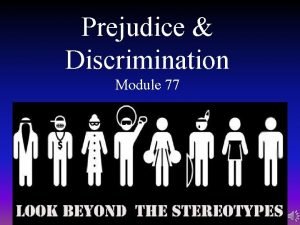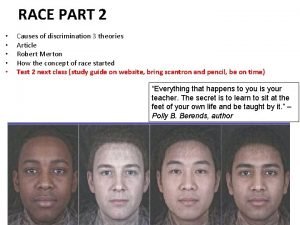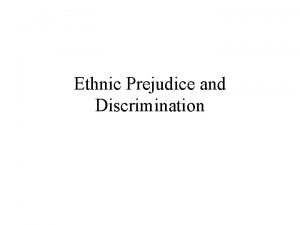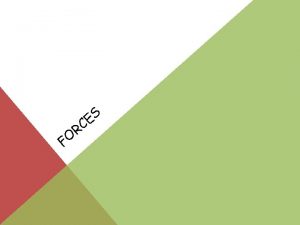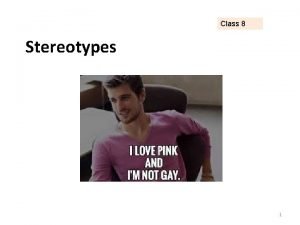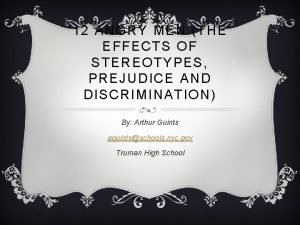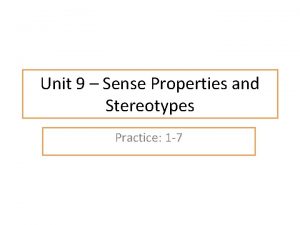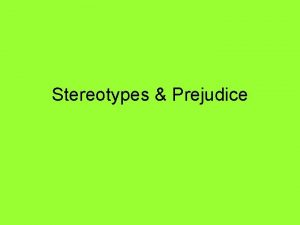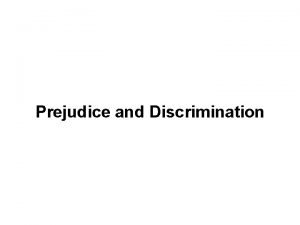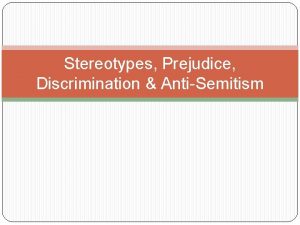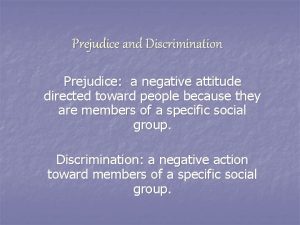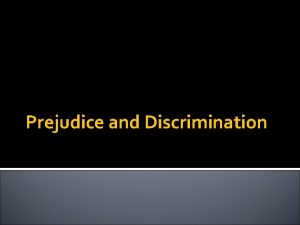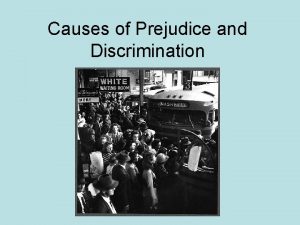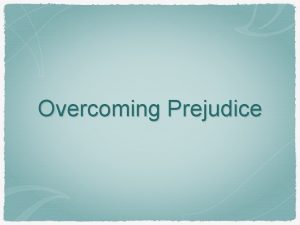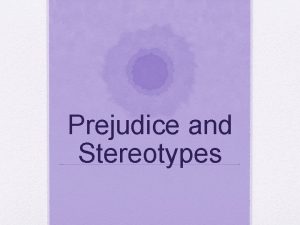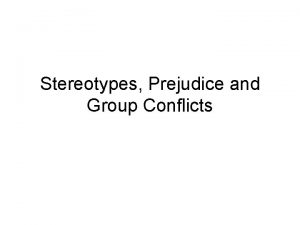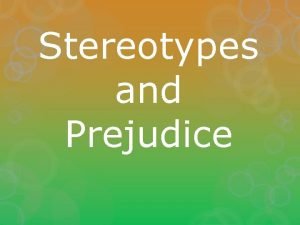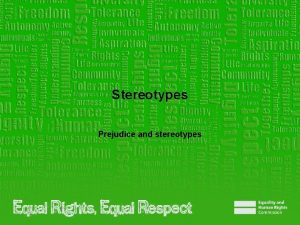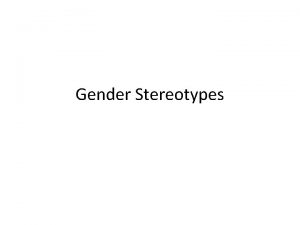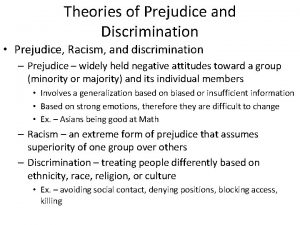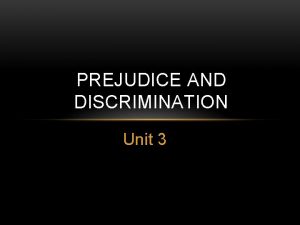Framework Prejudice Negative Contact Discrimination Stereotypes Discrimination Causes





















- Slides: 21

Framework Prejudice Negative Contact Discrimination Stereotypes

Discrimination Causes of How to reduce it

What is discrimination? • Unequal treatment or behavior toward members of different groups – E. g. , Dear White Boss article, Black bosses with black subordinates are more likely to be scrutinized • Qs: Differences in consequences of – Stereotypes vs. prejudice vs. discrimination?

What causes discrimination? Attitudes toward discrimination Intention To discriminate Subjective Norms for Discrimination Discriminatory Behavior

What are attitudes? • Evaluative thoughts & feelings – Vs Stereotypes? – Vs. Prejudice?

Attitudes Evaluations Negative Feelings Negative Thoughts Prejudice Negative Associations Positive Associations Stereotypes

What affects attitudes toward discrimination? Belief that discrimination leads to certain outcomes Value of outcomes of discrimination Attitudes toward Discrimination Intention to discriminate

What causes discrimination? Attitudes toward discrimination Intention To discriminate Subjective Norms for Discrimination Discriminatory Behavior

What are subjective norms? • What do you think other people think/feel about something? – Vs. Attitudes?

What affects subjective norms toward discrimination? Person’s belief Person’s motivation to that others want comply with others’ person to wishes discriminate Subjective Norms for Discrimination Intention to discriminate

Beliefs that discrimination leads to certain outcomes Value of outcomes of discrimination Attitudes toward discrimination Intention To discriminate Belief that others want person to discriminate Subjective Norm Motivation to comply with others’ wishes Putting it together: What causes discrimination?

Discrimination Causes of How to reduce it

Change beliefs about rewards vs. costs of discriminatory behavior • e. g. expectation of reward for hiring visible minorities Change Attitudes toward discrimination Change value of outcomes of discrimination e. g. lawsuits for discrimination How to directly change attitudes?

• Change awareness of definition & results of discrimination • E. g. , Using “weight” as a criterion for hiring can result in lawsuit if “weight” is not established as a BFOQ Change beliefs about rewards vs. costs of discriminatory behavior Change Attitudes Change value of outcomes of discrimination How to indirectly change attitudes?

How to directly change subjective norms? Change norm e. g. , CEO’s public behavior Change perception of norm (awareness) Change person’s motivation to comply with (unchanged) norm Subjective Norms for Discrimination Intention to discriminate

Application of model Change perceptions of costs of discriminating against Gays • E. g. , Removal of student from residence hall for repeat offences, or inadmission into residence halls in subsequent years Change belief that others Approve of discrimination Toward gays e. g. , Popular (influential) students’ beliefs about gay harassment Attitudes toward gays Intention to Discriminate Against gays Subjective Norm to Discriminate against gays

Processes underlying Managing Diversity • Changes in structure, practices, incentives, norms to promote fairness changes behavior and attitudes • Theory of reasoned action • Reinforcement theory • Negative sanctions toward discriminatory behavior reduces it • Theory of reasoned action • Reinforcement theory

Processes underlying Valuing Diversity Organizational Values • When authority figures emphasize fairness or equality values (e. g. , in mission statement) AND follow up with own behavior or implement relevant rules, THEN behavior changes • Theory of reasoned action

When behavior changes first…. . Cognitive Dissonance Theory Non-discriminatory behavior Discriminatory Attitude Dissonance Discomfort Derogate “non-performed” alternative (e. g. , attitude) Change Attitude toward discrimination to be consistent with behavior

Non discriminatory behaviors e. g. , Choose to argue against your position voluntarily; Cooperate w/ outgroup Discriminatory Attitude Dissonance Insufficient justification for voluntary behavior Change Attitude toward discrimination

Beliefs that discrimination leads to certain outcomes Value of outcomes of discrimination Attitudes toward discrimination Intention To discriminate Belief that others want person to discriminate Subjective Norm Motivation to comply with others’ wishes
 Usually negative, _____ is an attitude or prejudgment.
Usually negative, _____ is an attitude or prejudgment. Allport's scale of prejudice
Allport's scale of prejudice Merton's typology of prejudice and discrimination
Merton's typology of prejudice and discrimination Langkah teks eksplanasi
Langkah teks eksplanasi Contact and non contact force examples
Contact and non contact force examples Disadvantages of sliding contact bearing
Disadvantages of sliding contact bearing What is non contact force
What is non contact force Is tension force contact or noncontact
Is tension force contact or noncontact Paranochyia
Paranochyia Air resistance contact or non contact
Air resistance contact or non contact Thermoelectric cooler
Thermoelectric cooler Post encounter stage in service marketing
Post encounter stage in service marketing What are some contact forces and some noncontact forces?
What are some contact forces and some noncontact forces? Contact and non contact forces
Contact and non contact forces Proximate causation biology example
Proximate causation biology example Proximate cause ap bio
Proximate cause ap bio Slovenia stereotypes
Slovenia stereotypes Animal stereotypes in fables
Animal stereotypes in fables Language stereotypes
Language stereotypes Stereotypes spielverhalten
Stereotypes spielverhalten 12 angry men stereotypes
12 angry men stereotypes Sense properties and stereotypes
Sense properties and stereotypes
